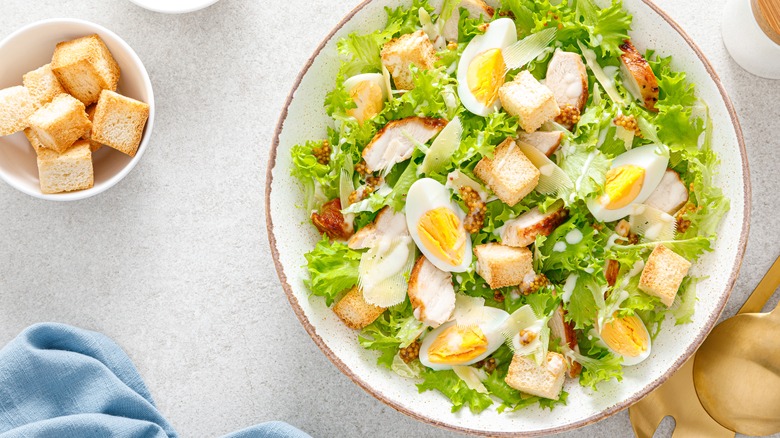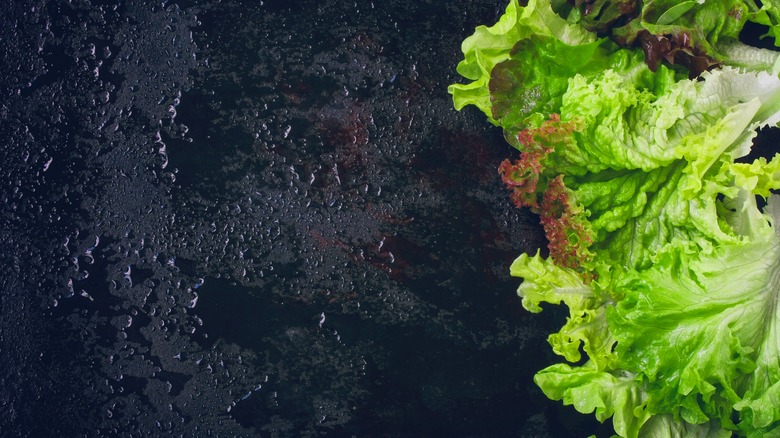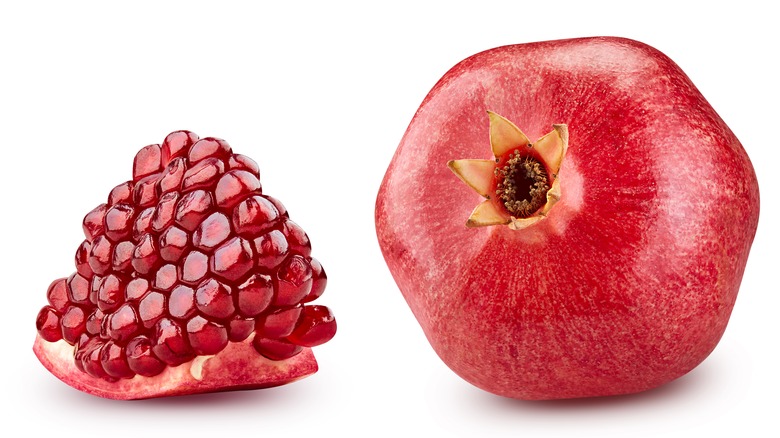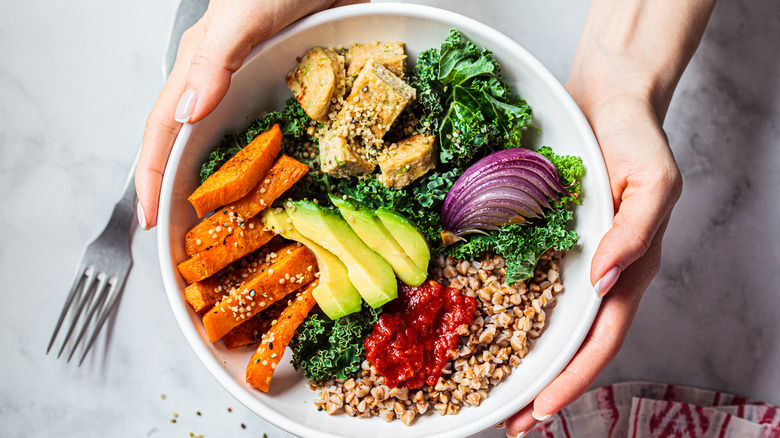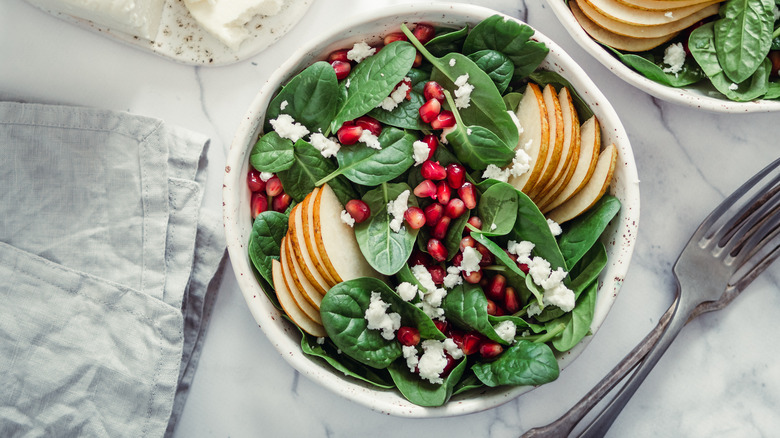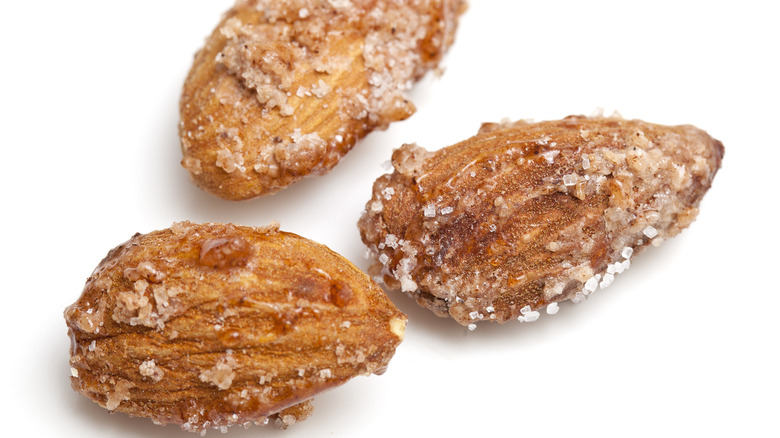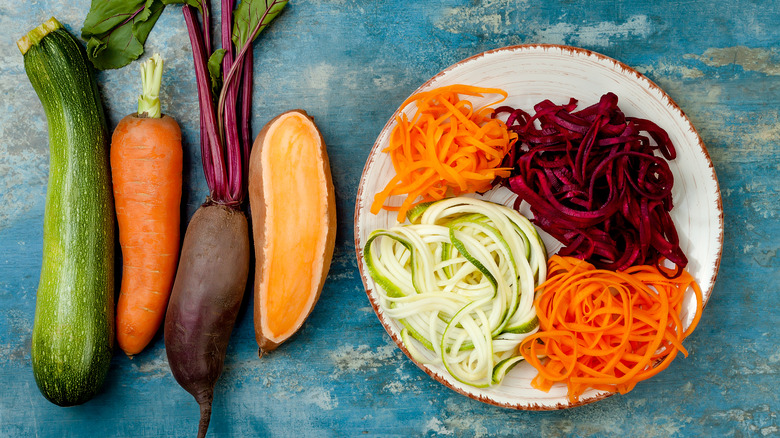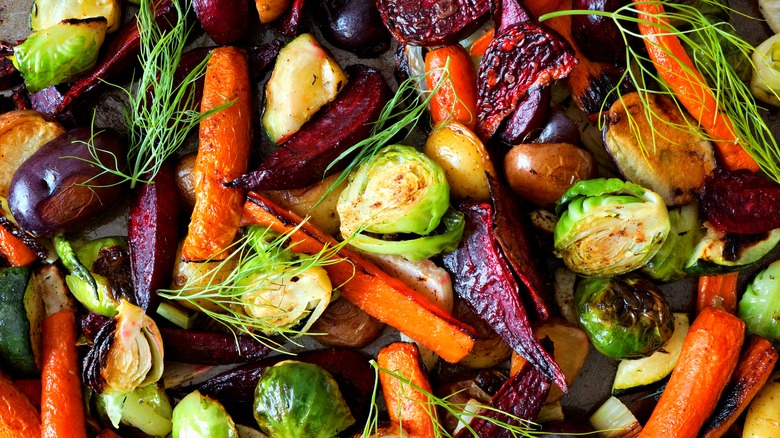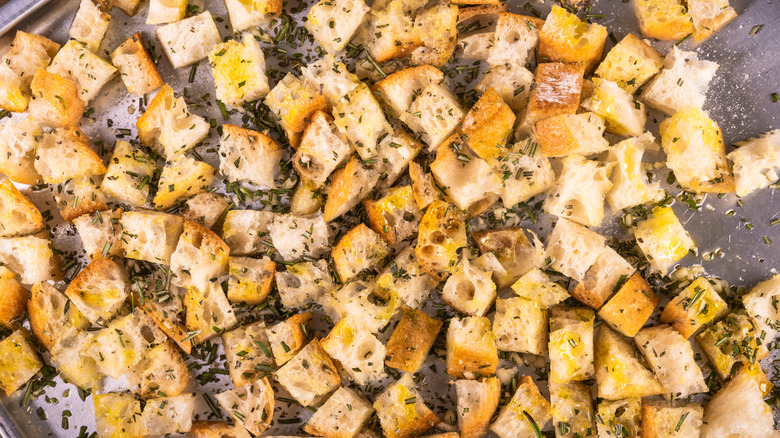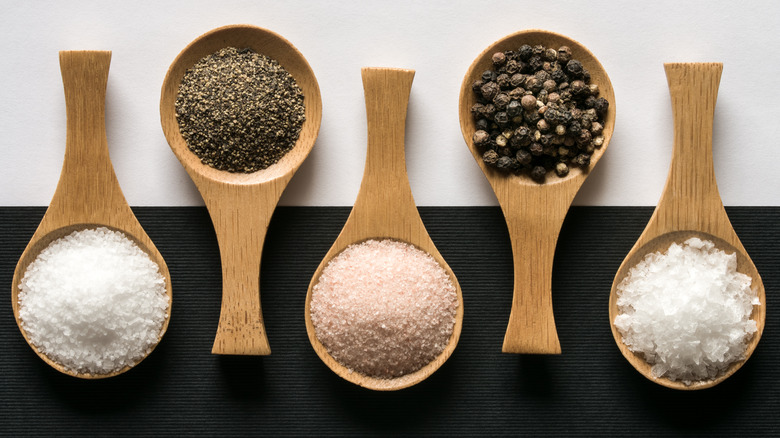10 Methods You Need To Know For Presenting Beautiful Salads
Why is it that restaurant salads look so incredible? Meanwhile, your homemade salads are tossed together with dressing and tend to look like a soggy mess: Just kinda blah. There's a lot that goes into presenting an appealing salad. After all, people eat with their eyes first before a bite crosses their lips, so if you want to wow, then you'll want to focus on the details.
What does this mean? That means that not only do you want to choose only the best and freshest ingredients to include in your salads, but you will also want to spend the extra time putting everything together. Salads shouldn't be a thrown-together afterthought; they should be a planned course in and of themselves.
If you want a five-star-worthy salad, then there are some tricks and tips that you can follow. Since salads seem so simple, it's easy for them to be an overlooked basic first course. But you can dazzle your dinner guests with a few very easy improvements to step up your salad game. Whether your salad is an opener for a larger meal or part of the main course itself, you can make sure your greens are on point and the envy of the dinner table.
1. Make sure your greens are hydrated and crisp
The base of most salads is leafy greens, whether it's lettuce, arugula, or spinach. Like a house, you want your salad to have a solid foundation, and that means using only the freshest greens that are at the height of crispness.
Using lettuce that's turning brown or past, its prime is just setting yourself up for failure. The last thing you want is your guests biting into a limp, dehydrated leaf of lettuce. If you find that your lettuce looks slightly wilted, you can typically revive it by soaking the leaves in ice water.
The ice bath will replump the dehydrated cells of the greens and bring back the faded crunch. So a half hour before you want to start putting your salad together, soak the greens soaking in a bowl of water and ice, and you'll be building yourself a very solid salad.
Don't forget to season your salad greens, as well. Just a pinch of salt and pepper makes a huge difference when you're serving your finished product. The seasoning will make all the flavors of your salad pop, so don't even think about serving your salad without crispy, flavorful greens as your base.
2. Pomegranate seeds make for beautiful additions
You can immediately elevate your salads by scattering a handful of pomegranate seeds onto the greens and across the plate. Not only do pomegranate seeds shine like delicate gems, but they are also incredibly nutritious.
Though you might be tempted to buy pre-packaged pomegranate seeds, save yourself the extra cost and buy a whole fruit and pluck out the seeds yourself. Though it might seem intimidating and messy at first, it's actually easy to remove pomegranate seeds.
All you need is a sharp knife and a bowl of water. Just cut your whole pomegranate into sections, submerge the sections in water, and gently use your fingers to remove the seeds from the white pith. Then, just drain the water from the bowl, and you'll have a nice collection of gorgeous pomegranate seeds with no staining and no mess!
Once you have the seeds, they can be added as a final touch to your salads, artfully scattered on top of the plated vegetables to give that pop of both color, flavor, and texture that will truly elevate your salad course.
3. If you're adding an avocado, don't let it go brown
Creamy and nutritious avocado had gone from a fad fruit into a true culinary staple. It's almost impossible to recall a time when avocados were ubiquitous on toast, in smoothies, and, yes, on salads!
One of the inevitable issues with avocados, though, is their delicate nature. They brown quickly, and it's hard to keep them looking fresh, even if they've been cut only hours (sometimes even minutes) beforehand.
If you want your salads to look truly professional, you don't want to top them with browned avocado, as it will give the whole dish an appearance of not being fresh. So don't sabotage yourself, and try using some different ways of keeping your avocados fresh.
You could wait to slice your avocado until right before you're about to serve the salads, but if you need to prep everything ahead of time, you could brush your sliced avocado with olive oil to keep it from oxidizing or keep your avocado slices in a mixture of lemon juice and water.
Both of these methods place a barrier between the finicky avocado flesh and the air, which is the real villain of the story. The less your avocado is exposed to air, the better it will look, so make sure it's one of the final touches that you add before your salads hit the table.
4. Use crumbled cheeses instead of shredded cheese
Bagged and shredded cheese works in a pinch or when you're packing your daily lunch in a mason jar for work. But if you're looking to impress, leave the shreds in the fridge and go for chunkier cheese crumbles. No one knows cheeses like the great state of Wisconsin. The Wisconsin Cheeseman recommends using crumbly, drier cheeses like feta and blue cheese in salads.
These cheeses can be broken down into perfect, fork-sized pieces that will look much more professional than shreds. If you wanted to include the snappy flavor of cheddar in your salad, you can add chunky, squeaky cheese curds. Crumbles and curds, with their irregular shapes, add way more visual interest to your salads than the predictability of shredded cheese.
Of course, dry parmesan cheese is one of the most popular salad cheeses. The flavor of parmesan is too intense for most people to cut it into chunks for your salad. But that doesn't mean you have to shred it.
You can grate it into a fine dust, creating a snowy effect on your salad. Or you can use your vegetable peeler to create beautiful curls directly from a block of parmesan. The curls will look incredibly elegant, and the cheese will taste fresher when it has just been cut from the block.
5. Candied nuts or seeds add sparkle and texture
If you're not adding nuts or seeds to your salads, you're missing out on a whole level of texture and flavor. Sunflower seeds, pumpkin seeds, flax seeds, almonds, walnuts, and pecans all add their own burst of flavor and loads of additional nutrients. Most nuts contain a combination of healthy fats and protein, which makes them an ideal component of salads.
Not only are nuts and seeds nutritionally beneficial, but they are also very visually appealing. Almost all nuts can just be added directly to your salads, but if you want to step up your game, you can make candied nuts before tossing them into the salad.
Pecans are the standard choice for a candied nut, but they don't have to be your only option. Walnuts, almonds, and pistachios will hold up to the candying process. By mixing some brown sugar, large-grain salt, melted butter, and any additional spices you might want (a pinch of cayenne brings the heat, while a bit of ginger marries well with fruit), you can either make candied nuts and seeds in a pan on the stovetop or spread them out on a sheet pan and pop them in the oven.
The sugars will caramelize and give an additional pleasant crunchy coating to the nuts. The candied coating will add sparkle and shine to the nuts, making them stand out nicely and demonstrating that you're not afraid to go the extra mile for your salads.
6. Vary the cuts of your vegetables
If you want your salad to really look fancy, you'll want to change the way that you cut your vegetables. You can use a mandolin or a vegetable peeler to get ribbon-thin slices of veggies. Curls of carrots look much more interesting than just your standard coin-cut slices. Cutting onions thinly keeps their pungent flavor from being too overwhelming.
There are a few basic knife skills that every home chef should master, specifically the julienne, brunoise, and chiffonade cuts. The julienne cut creates long, rectangular match-sticks. If you chop down the length of those strips, you'll end up with perfect little cubes, which is the brunoise cut. Vegetables like radishes, carrots, and peppers all benefit from these cuts.
The chiffonade cut is best suited to fresh herbs, such as basil and sage. You roll the leaves of the herbs into a tight tube like you're rolling a cigar, then use a sharp knife to slice down the length of the tube, resulting in gorgeous, ribbon-like tendrils. Using these different cuts adds visual appeal and helps add strong flavors (like fresh basil) in controlled amounts.
7. Section citrus fruit and remove the pith
Adding citrus fruits, especially orange and grapefruit, is a fantastic way of adding bright notes to your salads. Grapefruit plays nicely with lots of different greens, cheeses, and nuts.
While it might seem straightforward to peel and add your citrus fruit to your salads, if you want your dish to look extra professional, you'll want to make sure that your citrus fruit is properly sectioned. To do this, you need a sharp knife and a cutting board.
You'll want to remove both ends of the citrus fruit so that it can be rested on the flat-cut end. Then, you'll want to follow the curve of the fruit and slice away the tough outer skin, cutting as close to the flesh of the fruit as possible.
This way, you're removing the bitter white part of the skin called the pith. This is especially important because removing the pith not only makes your cut citrus look more professional but it also improves the flavor and makes the fruit less stringy.
Once the pith has been cut away, you'll see the natural lines of the citrus sections. Cutting in at an angle will help you remove the citrus sections from the natural membrane. Removing this membrane also improves the texture of the fruit. It might seem like a lot of work, but it truly takes your salads to the next level.
8. Integrate roasted vegetables for visual appeal
There's no culinary law which states that the vegetables in a salad need to be raw. To that end, adding a few roasted vegetables to your salad will not only add visual appeal to your dish, but it will also change the flavor profile of the cooked veggies.
Typically, when you roast vegetables, it makes them a bit sweeter and softens them. Carrots, sweet potatoes, beets, and brussels sprouts are excellent choices for adding roasted vegetables to salads. The roasting process caramelizes the veggies and deepens their flavor. Autumnal and winter salads especially benefit from the flavors that are brought out by roasting.
Summer salads, on the other hand, can be enhanced by adding grilled fruits. Pineapples, citrus fruits, peaches, and even watermelon can be placed on the grill so that the Maillard reaction leads to an incredible caramelization process of sugars and proteins in the food.
Adding roasted or grilled components will add incredible dimensions to your salad both in terms of appearance and flavor, elevating it well above just a regular plate of cut-up raw veggies.
9. Add crunchy homemade croutons
Croutons offer an easy and tasty way of adding texture and flavor to your salads. Depending on what sort of bread you use for your croutons, they can change up the flavor profile of your salads as well.
You can use any variety of bread to make your own croutons, and the bread doesn't have to be fresh, either. So if you have a length of ciabatta leftover from your Italian dinner the other night or the last half of a loaf of rye that's starting to go stale, you can rip it up into various fork-sized pieces and mix them in oil, herbs, and garlic before tossing them onto a sheet pan in the oven.
Use your hands to tear up the bread, too, instead of cutting it up with a knife. That way, you get unique shapes with your bready bits instead of uniform croutons. Much like the cheese crumbles from earlier, having differing shapes is more aesthetically appealing.
If you're making your salad ahead of time, don't add your croutons until you're just about to serve the salad. Croutons are there to add crunch, so they lose their appeal if they get soggy while they're waiting around in the fridge, coated in dressing.
10. Season with large crystal finishing salt after plating
Seasoning your salad is a crucial step that is often missed when you're preparing salads at home. You can rest assured that one of the things that makes restaurant salads pop is that the greens get a healthy pinch of salt and pepper before you tuck into them. If you want to make sure that your dinner party salads have that hidden wow factor, make sure you season your greens before you add the dressing and other components.
Once your salads are assembled, you can then do your best dramatic chef impression and sprinkle your finished salad with a pinch of sel gris, fleur de sel, or Himalayan pink salt. These salts have different mineral compositions than standard table salts.
Sel gris and fleur de sel are sea salts that contain additional minerals from the regions of the seas where they are harvested. Their delicate flavors and larger crystals make them ideal for adding to a salad as a finishing touch. The large flakes of salt will be more visible and artistic than your standard table salt.
Himalayan pink salt doesn't diverge too drastically in its mineral composition from standard sea salt, but its striking visual appearance makes it an ideal finishing salt. This final step of adding a flick of salt to your greens might seem trivial, but it truly does separate the amateur from the professional culinarians.
